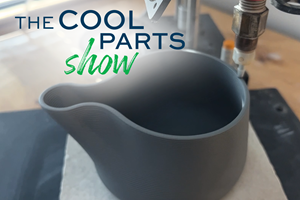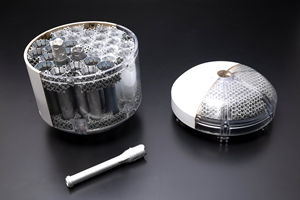AM Brings Down the Wall Between Manufacturing and Design
In additive manufacturing, design and manufacturing blend together. They can’t be separate if AM is to realize its promise.
When I was studying engineering, the College of Engineering had its classrooms and facilities in one building and the College of Design, Architecture, Art and Planning was located in another. Academically, students in engineering and students in “DAAP” (said as one word, “dap”) didn’t have much contact with one another.
Little did we future engineers know that another divide was coming. Out in the world, engineering itself is split by a roughly equivalent internal separation. Design engineers conceive products and manufacturing engineers produce them, frequently with too little communication between the two. Because of the potential for wasted cost if a tolerance is too tight or a feature is too difficult to make, it is considered a victory if design engineering and manufacturing engineering can just come to the table to talk.
Now, enter additive manufacturing (AM). In additive, even this separation—different departments occasionally talking—is too much distance. In additive, design and manufacturing blend. AM’s freedom of geometry means physical part-making is an aspect of design exploration. And AM’s freedom from dedicated tooling means the work of improving, refining and tweaking a design can continue well after manufacturing is underway. In AM, the separation between manufacturing and design can and must end, and various stories we’ve recently posted are all about that wall of separation coming down.
GM is experiencing this change. The car maker expects to benefit from additive manufacturing as a means of production, but doing so will mean validating AM parts according to auto-industry requirements. The prove-out process necessary for this validation will rely on efficient workflow and interaction between digital design and physical part-making.
The faculty of Penn State University sees this change as well. A new AM master’s degree program here is, in philosophy and in name, a degree in additive manufacturing and design. Incorporating significant design content into the curriculum was recognized as being essential for equipping students to realize additive’s promise.
And Kimura Foundry is helping companies explore what it is like to innovate after the wall has fallen. Metal casting is a process characterized by legacy design because of its reliance on hard tooling, but Kimura uses no hard tooling. All its sand molds are made via AM, meaning customers can cast many different designs at once, change the design of an established part at will, and still enjoy short lead times.
Other stories exploring how AM and design interrelate involve new potential for hip implants, the pursuit of victory in Formula 1 and a chef’s knife customized to its user.
The last item in particular is noteworthy. The knife is an AM product held in the hand, a product for a consumer. It is for a high-end consumer to be sure, but the product is a harbinger of what is to come. With additive today, design optimization often focuses purely on functionality. But in the future, we will all routinely touch, buy and interact with products made additively, and the success of these products will in part be determined by their visual and tactile appeal. It will be worth many design refinements to pursue this appeal, and the freedom of AM will allow for this exploration. Thus, in the future, the integration between manufacturing and design will need to go farther still. The wall of separation from artistic design will also come down. The Engineering and DAAP graduates will come together after all.
Related Content
3D Printed Lattices Replace Foam for Customized Helmet Padding: The Cool Parts Show #62
“Digital materials” resulting from engineered flexible polymer structures made through additive manufacturing are tunable to the application and can be tailored to the head of the wearer.
Read More3D Printed Ceramic Mug: The Cool Parts Show #48
MadeXBinary applies additive manufacturing to clay. The company achieves automated production of aesthetically pleasing kitchenware through digital pottery.
Read More3D Printed Lattice for Mars Sample Return Crash Landing: The Cool Parts Show Bonus
NASA Jet Propulsion Laboratory employs laser powder bed fusion additive manufacturing plus chemical etching to create strong, lightweight lattice structures optimized to protect rock samples from Mars during their violent arrival on earth.
Read MoreDrones Take Flight with Metal and Polymer 3D Printed Parts: The Cool Parts Show Bonus
Drones produced by Cobra Aero now incorporate many 3D printed parts made through laser powder bed fusion and Multi Jet Fusion processes.
Read MoreRead Next
At General Atomics, Do Unmanned Aerial Systems Reveal the Future of Aircraft Manufacturing?
The maker of the Predator and SkyGuardian remote aircraft can implement additive manufacturing more rapidly and widely than the makers of other types of planes. The role of 3D printing in current and future UAS components hints at how far AM can go to save cost and time in aircraft production and design.
Read More4 Ways the Education and Training Challenge Is Different for Additive Manufacturing
The advance of additive manufacturing means we need more professionals educated in AM technology.
Read More3D Printing Brings Sustainability, Accessibility to Glass Manufacturing
Australian startup Maple Glass Printing has developed a process for extruding glass into artwork, lab implements and architectural elements. Along the way, the company has also found more efficient ways of recycling this material.
Read More


















